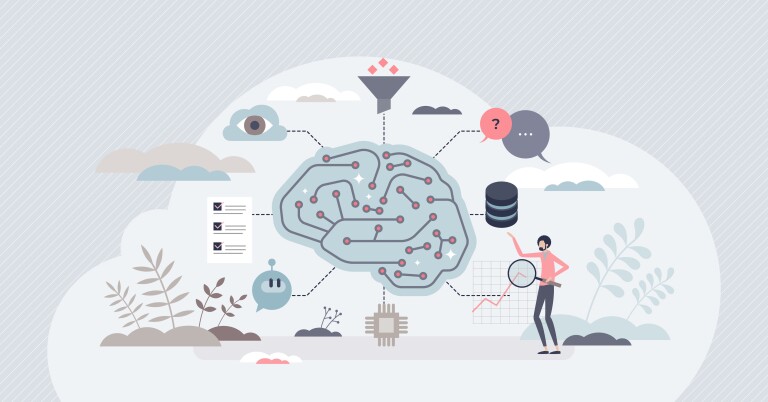Higher education institutions are racing to keep pace with the disruption caused by artificial intelligence (AI) tools. A 2023 QuickPoll survey by Educause found that 83% of higher education stakeholders believe generative AI will "profoundly change" the sector over the next three to five years. Additionally, 65% agreed that "the use of generative AI in higher ed has more benefits than drawbacks" (McCormack, 2023, Table 1). While institutions are exploring AI's potential in areas such as admissions, enrollment, administrative duties, scheduling, and institutional data research, this piece focuses on the overarching risks and rewards AI presents in teaching and learning.
When OpenAI released ChatGPT in November 2022, it became evident by the following spring that generative AI was becoming a significant force in education. Since then, familiarity with and use of AI in classrooms has grown exponentially, alongside advancements in AI models and the emergence of numerous companies offering a diverse slate of AI products. For example, researchers found that nearly all educators and students had heard of ChatGPT, though only a quarter of U.S. students used it weekly or daily. Among U.S. faculty, 10% reported using it for non-research purposes, while 30% reported using it for research (Smolansky et al., 2023).
Given the intense interest in whether generative AI will increase academic dishonesty, it’s notable that educators rated its impact higher than students did. While students appreciate generative AI, they worry it could stifle creativity or lead educators to overcorrect by shifting assignments from creating to merely editing or analyzing content. For instance, some students felt that focusing on debugging AI-generated code rather than writing it hindered their learning, as they wanted to learn how to code—not just analyze existing code (Smolansky et al., 2023).
The benefits of AI come with risks, including biases in data and among developers, privacy issues related to data collection, a lack of data comprehensiveness, security vulnerabilities, opaqueness in a tool’s operations, and increased plagiarism (Bhise et al., 2022). The challenge in online learning is addressing these concerns while integrating AI's benefits into course design and delivery. In teaching and learning, AI holds the promise to improve the quality and efficiency of online course design if applied with careful attention to sound educational theories. The goal should be to use AI to support teaching and learning with the aim of enhancing student motivation and knowledge, rather than simply using it because it is new and exciting.
One effective strategy for incorporating AI is integrating it into a backward design approach to course planning. A backward design approach, which focuses on setting goals before choosing instructional methods and assessments, can help alleviate concerns about AI's role in education. Additionally, using AI to assist in developing course content can be a highly effective way to save faculty time while ensuring a cohesive and well-structured course. Educators can use AI to help brainstorm course objectives, topics, assignment types, quiz questions, and rubrics that align with course goals. However, it’s important to remember that generic AI prompts yield generic results; more detailed prompts will produce better outcomes. For example, instead of asking AI to "create course objectives for a business analytics course," you might say, "create 4–6 course objectives for an online, graduate-level business analytics course," followed by additional details such as course topics and course length.
When maintaining or revising a course that has been taught before, AI can help quickly repurpose quizzes and other instructional materials. For instance, AI can generate quiz questions based on previously created question sets, which can then be incorporated into course lecture pages or discussions as practice examples. AI writing tools like Grammarly can enhance lecture text by suggesting more inclusive language. Additionally, AI could suggest ideas for supplementary course materials, such as podcasts or reports, which can be particularly helpful if the course relies heavily on a textbook.
Finally, when facilitating a course online, AI can improve communication with students by rewriting announcements, checking for grammar errors, and editing for tone or inclusive language. Generative AI tools can also help draft general feedback and short summaries of relevant course content to send to students. Additionally, there is an impressive range of AI tools that can help personalize the course for students, such as flashcard makers and auto-transcription tools for multimedia that lack text-based alternatives.
Whether building, revising, or teaching a course, educators should be transparent about their AI expectations, such as whether students will be permitted to use specific AI tools. The same holds true for institutions implementing policies around the responsible use of AI. If institutions and educators have a plan to minimize the risks associated with generative AI, then generative AI tools can effectively enhance both the teaching and learning experience in online courses.
References
Bhise, A., Munshi, A., Rodrigues, A., & Sawant, V. (2022). Overview of AI in education. In P. P. Churi, S. Joshi, M. Elhoseny, & A. Omrane (Eds.), Artificial intelligence in higher education (pp. 31–62). CRC Press.
McCormack, M. (2023, April 17). EDUCAUSE QuickPoll results: Adopting and adapting to generative AI in higher ed tech. EDUCAUSE Review.
Smolansky, A., Cram, A., Raduescu, C., Zeivots, S., Huber, E., & Kizilcec, R. F. (2023). Educator and student perspectives on the impact of generative AI on assessments in higher education. In Proceedings of the tenth ACM conference on learning @ scale (pp. 378–382).

